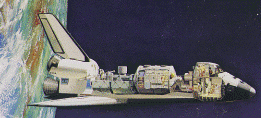|
|
|
|
Spacelab 1

The first Spacelab mission, in orbit in the payload bay of the Space Shuttle
(STS-9) from 28 November-8 December 1983, carried a multi-disciplinary
payload intended to demonstrate that good science could be done on short
shuttle flights.
An X-ray spectrometer, measuring 2-30 keV photons (although 2-80
keV was possible), was on the pallet. The primary science objective
was to study detailed spectral features in cosmic sources and their
temporal changes. The instrument was a gas scintillation proportional
counter (GSPC) with ~ 180 cm2 area and energy resolution of 9% at
7 keV. The detector was collimated to a 4.5 deg (FWHM) field of
view. There were 512 energy channels.
Data were accumulated for all intended targets. These included: Cyg
X-2, 4U1636-53, Her X-1, Coma, Cyg X-3, Perseus, Cyg X-1, Cas A,
Crab, Cen X-3, Cen X-2, and Vela X-1.
[Gallery] (http://heasarc.gsfc.nasa.gov/docs/heasarc/missions/images/spacelab_images.html)
[Publications] (http://heasarc.gsfc.nasa.gov/docs/heasarc/missions/biblio/spacelab_biblio.html)
|
|
